| | 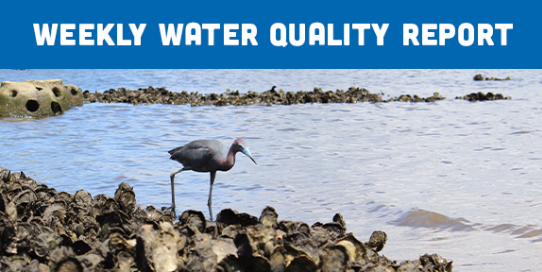 | Weekly Water Quality Report Florida Oceanographic Society provides a snapshot of local water quality conditions in the St. Lucie Estuary (SLE) and southern Indian River Lagoon (IRL) using data collected by our Citizen Science Water Quality Monitoring Program. This report provides an overview of ecosystem health and function for the SLE and IRL and includes a summary of additional water quality conditions from publicly available sources. |
| | Part 1: Florida Oceanographic Society's Water Quality Report |
| 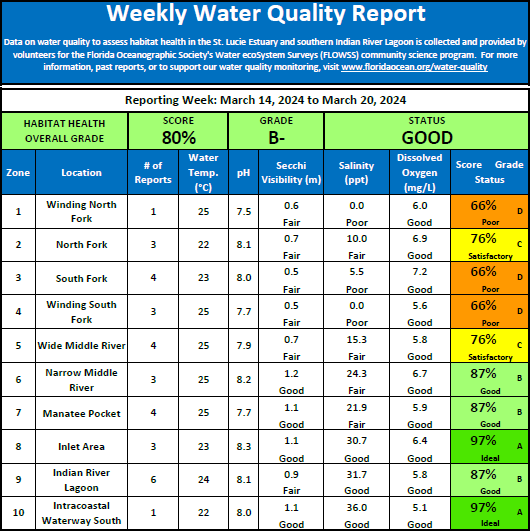 | | Figure 1. Florida Oceanographic Society's Weekly Water Quality Report for ecosystem health in the SLE and southern IRL. The breakdown is provided by each zone and location for the measured water quality parameter. Grading is based on Secchi visibility, salinity and dissolved oxygen levels. PDF of the full map with information on grading categories. | |
| | Disclaimer: The data above indicates changes in water quality parameters to evaluate habitat health. This map is not to be used to indicate current bacteria levels, nutrient levels, or the presence of harmful algae blooms. For up to date information on bacteria levels, visit the Florida Health Beaches Program. For up to date information on nutrients levels, visit ORCA Kilroy or HBOI LOBO. For up to date information about algae blooms, visit the Florida DEP's algae bloom dashboard. | |
|  | | Figure 2. Florida Oceanographic Society's Weekly Water Quality Map for the SLE and southern IRL. Grading is delineated by each zone, represented by both colors and their corresponding letter grade. | |
| | Summary of Weekly Water Quality for Habitat Health for Reporting Week This week’s water quality grade for habitat health in the SLE and southern IRL earned a “B-” based on water clarity, oxygen content, and salinity values in 32 reports across 10 zones. Discharges from Lake Okeechobee averaged 355 cfs over the last 7 days (current Lake Okeechobee daily status, see Table 2). Salinities across the SLE and IRL were poor – good across all zones. Figure 4 shows how these salinities affect oyster habitat health in the IRL. Water clarity (visibility) was graded as fair – good for seagrass health across all zones within the SLE and IRL. Throughout the SLE and IRL, dissolved oxygen levels were good at all sites. Disclaimer: The data found on this report is collected by citizen scientists who volunteer their time and effort for the FOS FLOWSS program. Although the data is screened, it comes with no warranties regarding the completeness, accuracy or reliability and is intended for educational and outreach use only. Learn more about the FOS Citizen Science Water Quality Monitoring Program. |
| 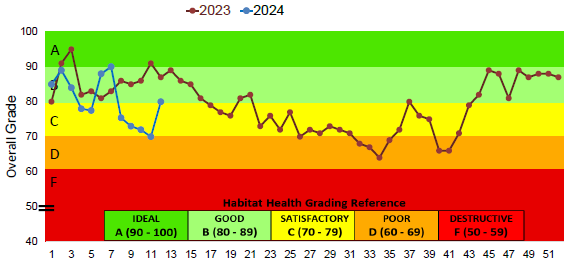 |
|
| | Figure 3. Weekly water quality grades for the SLE and southern IRL for 2022 (blue line) and 2023 (red line). | |
| 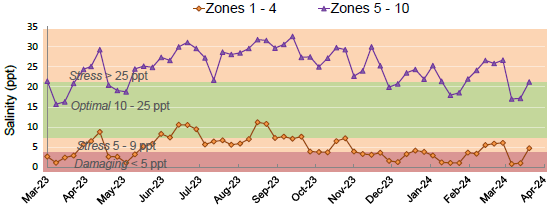 | | Part 2: Summary of Water Quality Updates Obtained from Publicly Available Sources |
| 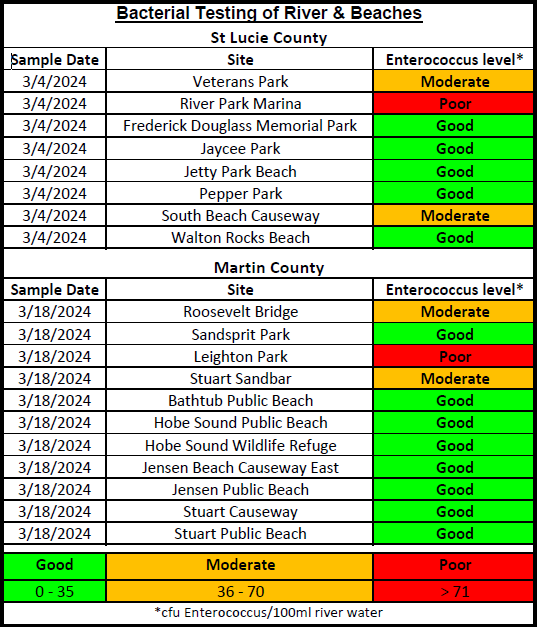 | | | FDEP Blue-Green Algal Blooms Report From the week of March 8, 2024 – March 14, 2024, FDEP reported algal bloom conditions in 9 of 23 samples collected. “The most recent usable satellite imagery for Lake Okeechobee is from 3/14 and shows moderate bloom potential on 15% of the lake, predominantly along the western shoreline, with more scattered bloom potential along the northern and southern shorelines of the lake. The most recent usable satellite imagery for the St. Lucie Estuary is from 3/14 and shows no bloom potential.” For more information on current algal blooms that could potentially affect our Treasure Coast waterways, you can view FDEP's Algal Bloom Sampling Status interactive map at the link below. |
| | |
|
| SFWMD Weekly Environmental Conditions Reports Lake Okeechobee: SFWMD reported on March 20th, 2024, “Lake Okeechobee stage was 15.75 feet NGVD on March 17, 2024, which was 0.19 feet lower than the previous week and 0.58 feet lower than a month ago. Average daily inflows (excluding rainfall) decreased from the previous week, going from 2,530 cfs to 1,570 cfs. Average daily outflows (excluding evapotranspiration) also decreased from the previous week, going from 8,410 cfs to 4,210 cfs. The seventh wading bird foraging survey of the 2024 breeding season (conducted March 14, 2024) reported approximately 4,300 wading birds actively foraging on the Lake. The March 14, 2024, satellite image from NOAA’s Harmful Algal Bloom Monitoring System suggested a moderate bloom risk along most of the north, west and south shorelines of the Lake.” St. Lucie Estuary: SFWMD reported that “Total inflow to the St. Lucie Estuary averaged 470 cfs over the past week with most of the flow coming from Lake Okeechobee. Mean salinities increased at all three sites within the estuary over the past week. Salinity in the middle estuary was in the lower stressed range (5-10) for adult eastern oysters.” |
| |  | | | Lake Okeechobee Discharges Virtual Town Hall Lake Okeechobee is a vital ecosystem, but its management presents complex challenges, particularly concerning the discharge of water into our coastal ecosystems. Join us on April 2nd at 6:30 pm for an informative virtual town hall where we will delve into the various aspects surrounding this issue, including its environmental impact, its implications for local communities, and potential solutions moving forward. We encourage active participation from attendees like you. This is your opportunity to ask questions, share your concerns, and contribute to the conversation. Whether you're a concerned citizen, a community leader, or someone with a keen interest in environmental conservation, your presence at this town hall is invaluable. |
| | | Reporting Observations for the Indian River Lagoon Algal Bloom Monitoring: To report potential blue-green algal blooms, contact FDEP through their online form here or call 800-636-0511.
Fish Kills Hotline: Please report observations of fish kills or diseased fish to the FWC Fish Kill Hotline through their online form here or call 800-636-0511.
IRL Otter Spotter Project: Have you seen a river otter?
Report it here!
IRL Diamondback Terrapin Sightings: Have you seen a diamondback terrapin?
Report it here!
Sawfish Sightings: Have you been lucky enough to spot a sawfish?
Report it here! Dolphin Spotter: Have you seen a dolphin?
Report it here! Horseshoe Crab Spotter: Have you seen horseshoe crabs?
Report it here!
Manatee Reporting: To report sick, injured, or dead manatees to FWC call 888-404-FWCC (888-404-3922). |
| |
|
| Water Quality Report compiled by
Florida Oceanographic Society
890 NE Ocean Blvd, Stuart, FL 34996
Website: FloridaOcean.org
Questions? Contact our Research Department:
Email: nwinn@floridaocean.org
Office: 772-225-0505 ext. 114 |
| | Florida Oceanographic Society's mission is to inspire environmental stewardship of Florida’s coastal ecosystems through education, research and advocacy. | |
| | | This weekly report is made possible through the support of our members and generous donors. Please help Florida Oceanographic Society continue our critical monitoring and restoration efforts in local waterways by making a donation or becoming a member today! | |
|  | |  | |  | |
|
| | Florida Oceanographic Society
890 Northeast Ocean Blvd., | Stuart, Florida 34996
772.225.0505 | info@floridaocean.org |
| |
|
| |
|
|